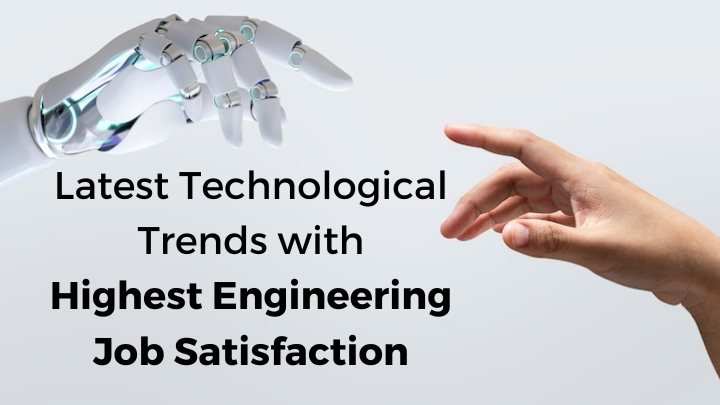
Engineering is a popular and growing profession. As new technologies ramp up and they see widespread adoption to enhance business decisions and outcomes, the demand for engineers will likely grow and evolve. If you want to be in an in-demand and specialized area of engineering, take a look at the top 7 technology trends that gives engineering job satisfaction.
Check out this detailed case study blog article which focuses on the said niche area.
1. Artificial Intelligence and Machine Learning (AI and ML)
Artificial Intelligence (AI) has been growing and evolving in many different industries in recent years. Though it’s been around since the mid century, it continues to evolve in its industrial uses and stays a top technology trend. The collection of technologies that comprise AI has the ability to revolutionize virtually every aspect of our lives. From virtual assistants to surgical robots to navigation apps, there’s no limit to what AI can do.
Based on information from Markets to Markets, AI is expected to grow to $190 billion by 2025. Roughly $57 billion of that total will apply to AI and cognitive systems. Once AI sees more use cases in different industries and sectors, we can expect to see a greater demand for AI engineers. This specialization also boasts some of the highest salaries.
Machine Learning (ML), a subset of AI, is among the technologies that are expected to grow. The demand for skilled engineers for machine learning will only increase as it gets more adoption and applications in different industries. According to Forrester, AI, machine learning, and automation will likely represent 9% of the new jobs in the US by 2025.
2. Virtual Reality and Augmented Reality (VR and AR)
Virtual reality (VR) and augmented reality (AR) are another hot group of technologies that’s been in the public eye recently. They’re similar, but they differ in that VR is about creating immersive experiences, while AR enhances the existing environment. There is a fine line between these two, which also gets blurred when you go from XR.
Both of these technologies have widespread use in entertainment, such as gaming, but more industries are finding uses for both VR and AR. The market is expected to grow globally to over $209 billion by 2022, especially as more applications and use cases are realized. AR and VR technologies are getting used in wide domains including healthcare, education, simulations, police training, automobile, architecture and many others.
3. Internet of Things (IoT)
The Internet of Things (IoT) is one of the biggest technology trends for both consumers and businesses alike. Appliances, vehicles, wearables, and more all offer opportunities in IoT, not to mention the industrial devices that allow businesses to leverage IoT for efficiency, safety, and insights based on data.
Predictive maintenance, healthcare, customer service, administrative services, and more represent different use cases for IoT, and that’s just the start of the possibilities. Based on forecasts, IoT devices in use could reach 50 million globally by 2030, expanding the network of connected devices. Global spending is expected to hit 1.1 trillion USD in 2022, offering plenty of job opportunities for engineers.

4. Robotic Process Automation
Robotic process automation (RPA) is a growing technology trend that’s used in automation. It facilitates the use of software to automate vital business processes, such as data processing, administrative tasks, financial transactions, and more. Because RPA takes on the mundane and time-consuming tasks that humans have to do, it frees time for employees to focus on more mission-critical or creative tasks.
Though RPA is using automation to replace some human workers, it’s creating more job opportunities for engineers and other roles. The majority of jobs can be partially automated, but the design, testing, and implementation of this technology offers plenty of career opportunities. Engineering jobs in RPA also offer high salaries and plenty of creative challenges.
5. Edge Computing and Quantum Computing
Organizations are amassing and processing more and more organizational data, pushing edge computing to the forefront. Edge computing is a solution to the latency and congestion of cloud computing, which occurs during the transfer from the IoT device to the cloud storage center. Edge computing processes data on the edge, staying near the data source and the end user, so businesses can process time-sensitive information in remote environments for actionable insights.
IoT adoption is increasing, so edge computing is likely to increase along with it. Edge computing is expected to reach nearly $7 billion, offering numerous jobs for engineers with a background in edge computing.
Likewise, quantum computing, a form of computing that uses quantum phenomena like quantum entanglement and interference to perform calculations, is also expected to grow. Quantum computing has the ability to process, search, monitor, analyze, and act on large quantities of data, offering potential for many industries. For example, the finance industry can use quantum computing for credit analysis, fraud detection, and more.
Quantum computing is expected to grow to $2.5 billion by 2029. Engineers in quantum computing need to have a lot of experience with machine learning, quantum mechanics, and probability.
6. Cyber Security
Cyber security isn’t a technology trend, but it’s integral to the rest of the technologies on this list. Technology has many benefits, but it comes with increasing cyber threats for businesses. Hackers realize the value of the sensitive business and customer data companies hold, making them an attractive target.
As long as there’s a prize worth stealing and ways to get to it, cyber security will be an important and continually evolving technology trend. Cyber security jobs are growing faster than other tech positions, in fact. According to Gartner, 60% of organizations will use cyber security risk to evaluate business partnerships and transactions by 2025.
7. 5G
5G is the next generation of cellular technology and a key trend relating to IoT. While the previous generations were important for the development of the internet and data-driven services, 5G has the potential to revolutionize the way we experience technology. Many new technologies rely on 5G, including cloud-based gaming, HD cameras, AR and VR, and more.
Telecommunications companies are developing 5G applications to accelerate the adoption of IoT devices. As a result, 5G networks are expected to expand to cover 40% of the world by 2024.

Conclusion:
Engineers have a bright future ahead.
Technologies are continuing to evolve, offering endless potential for engineers with specialization in these trends. As technology grows, so will the demand for skilled professionals with knowledge of these emerging trends.
Author Bio:
Subbu Seetharaman
Subbu Seetharaman is the Director Of Engineering, at Lantronix, a global provider of turnkey solutions and engineering services for the internet of things (IoT). Subbu is an engineering executive with over 25 years experience in leading software development teams, building geographically distributed, high performing teams involved in developing complex software products around programmable hardware devices.

